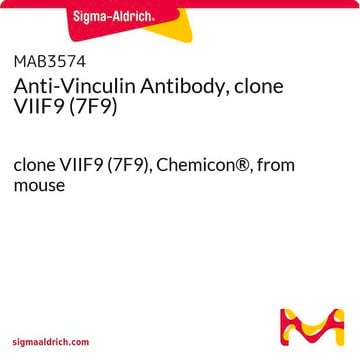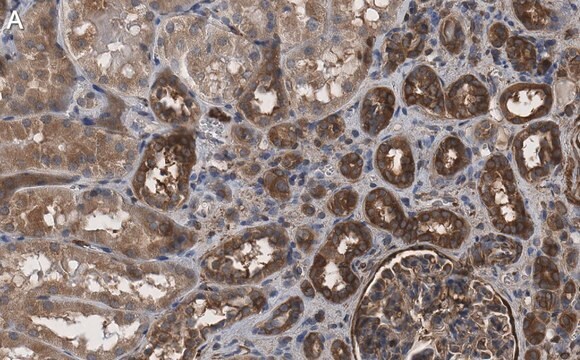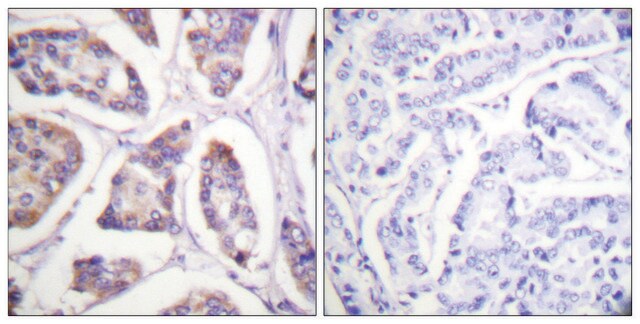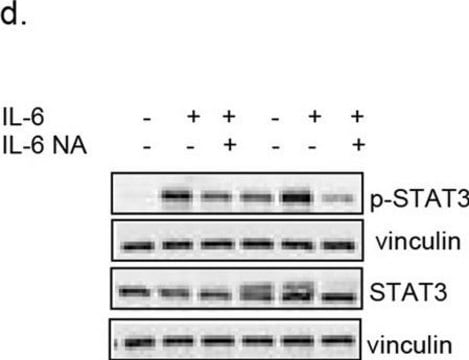There are no available papers that cite using clone VIN-11-5 with Drosophila vinculin. The specific epitope for this antibody has not been mapped. However, there is a paper that maps the epitope binding area of this antibody clone - JBC 266, 8734-8740. 1991, Fusun Kilic, et al. --> "Hence the epitope lies between cysteines 545 and 737." Please see the link below to review this publication:
https://www.sciencedirect.com/science/article/pii/S0021925818315072?via%3Dihub
V4505
Anti-Vinculin Antibody
mouse monoclonal, VIN-11-5
Sinonimo/i:
Vinculin Antibody Sigma, Anti-VCL
Scegli un formato
CHF 432.00
Scegli un formato
About This Item
CHF 432.00
Prodotti consigliati
Nome del prodotto
Monoclonal Anti-Vinculin antibody produced in mouse, clone VIN-11-5, ascites fluid
Origine biologica
mouse
Livello qualitativo
Coniugato
unconjugated
Forma dell’anticorpo
ascites fluid
Tipo di anticorpo
primary antibodies
Clone
VIN-11-5, monoclonal
PM
antigen 116 kDa
Reattività contro le specie
bovine, human, chicken, mouse
tecniche
indirect immunofluorescence: 1:50 using cultured chicken fibroblasts
microarray: suitable
western blot: suitable
Isotipo
IgG1
N° accesso UniProt
applicazioni
research pathology
Condizioni di spedizione
dry ice
Temperatura di conservazione
−20°C
modifica post-traduzionali bersaglio
unmodified
Informazioni sul gene
human ... VCL(7414)
mouse ... Vcl(22330)
Descrizione generale
Specificità
Immunogeno
Applicazioni
- western blotting.
- immunofluorescence.[1]
- immunocytochemistry.
Azioni biochim/fisiol
Altre note
SAB4200729 Anti-Vinculin antibody, Mouse monoclonal
clone VIN-11-5, purified from hybridoma cell culture
Esclusione di responsabilità
Non trovi il prodotto giusto?
Prova il nostro Motore di ricerca dei prodotti.
Prodotti correlati
Raccomandato
Codice della classe di stoccaggio
13 - Non Combustible Solids
Classe di pericolosità dell'acqua (WGK)
WGK 1
Punto d’infiammabilità (°F)
Not applicable
Punto d’infiammabilità (°C)
Not applicable
Scegli una delle versioni più recenti:
Certificati d'analisi (COA)
Non trovi la versione di tuo interesse?
Se hai bisogno di una versione specifica, puoi cercare il certificato tramite il numero di lotto.
Possiedi già questo prodotto?
I documenti relativi ai prodotti acquistati recentemente sono disponibili nell’Archivio dei documenti.
I clienti hanno visto anche
-
Hello! Has it been published or predicted if this antibody will react with Drosophila vinculin? Or, could you provide where in the human vinculin this antibody interacts?
1 answer-
Helpful?
-
Active Filters
Il team dei nostri ricercatori vanta grande esperienza in tutte le aree della ricerca quali Life Science, scienza dei materiali, sintesi chimica, cromatografia, discipline analitiche, ecc..
Contatta l'Assistenza Tecnica.
















